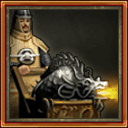Dragon Cannon 龍身炮 (Longshen Pao)
Three-Wheeled Wooden Vehicle with Chinese Dragon Cannon 龍身炮 (Longshen Pao) -
lit: "Dragon Bodied Cannon." Lanzhou, Gansu Province, China, 1875
By the late 19th century, nearly all of China's arms have fallen into obsolescence, in an age where modern global- spanning empires have all equipped themselves with repeater rifles, Gatling Guns and modern howitzers, the lumbering Qing dynasty still fielded culverins and swivel guns that were practically still frozen in their 16th century state.
However, despite their increased irrelevance, some were rather uniquely exquisite. One such weapon was the so called 龍身炮 Longshen Pao- or the Dragon Artillery. Likely based on the Ming dynasty "Thunder Roaring Cannon" which fires explosive fragmentation shells.
The dragon carving for the cannon- especially the bronze wrought barbels (whiskers) looked almost like its lifted out from a steampunk fantasy setting, but what's quite hard to comprehend is that this is indeed an actual weapon fielded by the Qing army.
Above: A similarly designed cannon wagon, likely another type of the Dragon Cannon with the
mounted over a three wheeled chassis-
A Ming dynasty wagon fort- similar to the Hussite, Cossack, Vootrekker Laagers. Cavalry reserves are placed
within and fort wagons~ armored with spikes and protruding blades would ring out as walls of the encampment.
Cannons such as the dragon cannon, breech loading swivel guns, and European- styled cannons would shoot from within, mostly fitted with a protective wooden screen in the front.
Out of the endless bad blood between the Ming and the Qing, both seemed to have the exact
preference for artillery. Some even have suggested that the Manchus purposely lagged the
development of cannon technology so that the many ethnic groups of the
empire would not rebel successfully.
In 1874-75, the Russian government sent a research and trading mission to China to seek out new overland routes to the Chinese market, report on prospects for increased commerce and locations for consulates and factories, and gather information about the Dungan Revolt then raging in parts of western China.
(It should be noted, that although the Qing Dynasty was modernizing its navy and its military infrastructure
at this time, this particular hotzone was located within the rural backwater of western China, therefore do we
see the Qing army confidently still using old equipment against a front that are still entirely composed of technologically inferior rebels.)
Most of the photographs are included in this album, which later became part of the Thereza Christina Maria Collection assembled by Emperor Pedro II of Brazil and given by him to the National Library of Brazil.
~
Thank you and Merry Christmas!
→ ☯ [Please support my work at Patreon] ☯ ←




















Comments